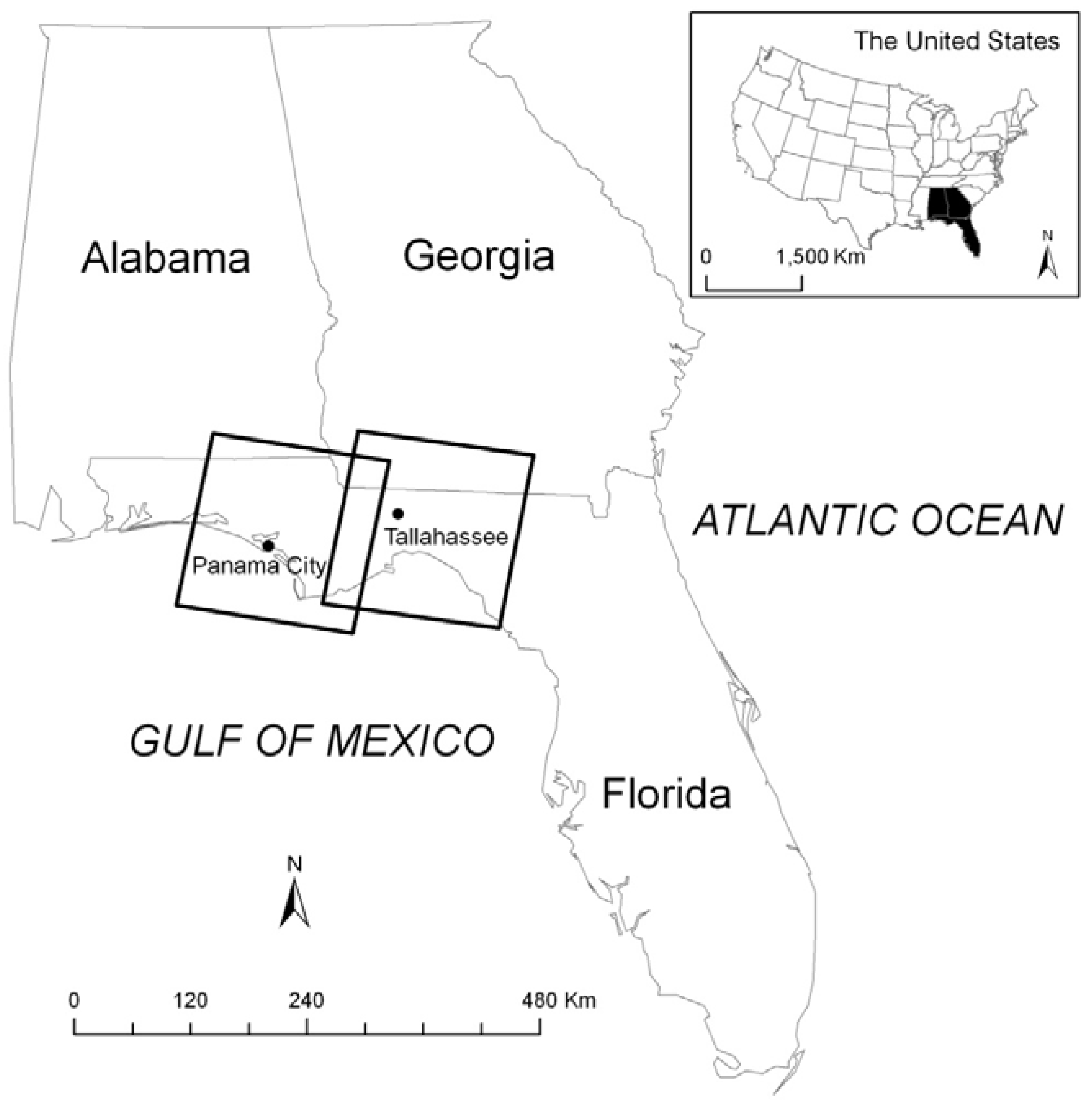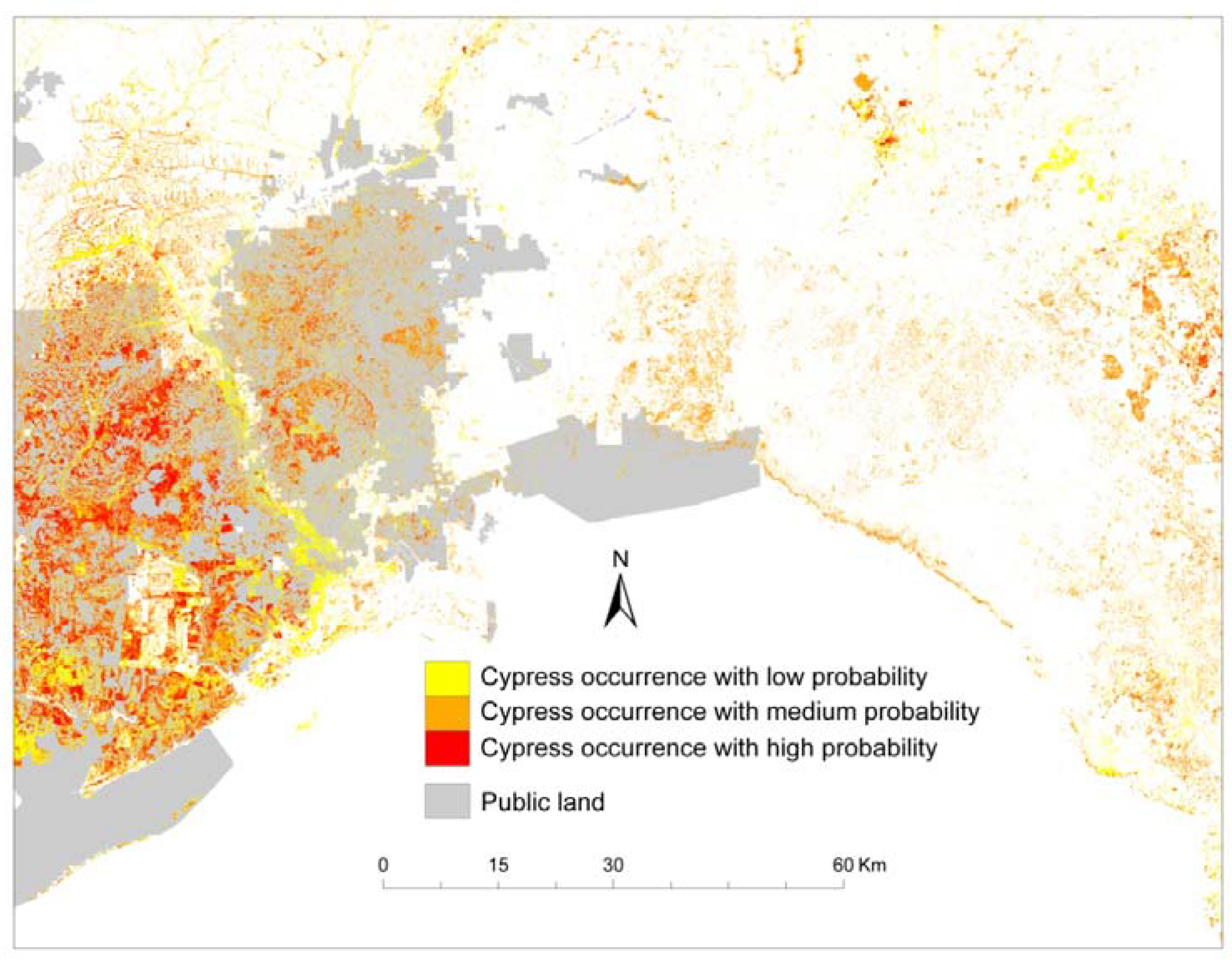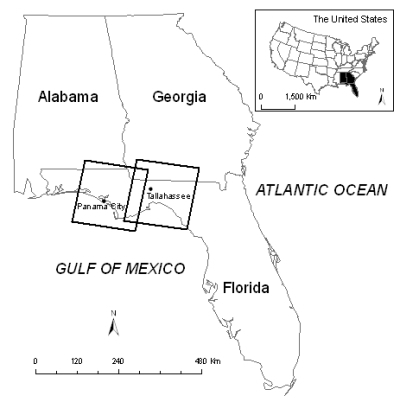Detection of Cypress Canopies in the Florida Panhandle Using Subpixel Analysis and GIS
Abstract
:1. Introduction
- Whether multitemporal analysis is able to improve classification accuracies of subpixel detections of cypress?
- Whether signatures developed in one scene can be used to classify another scene?
2. Experimental Section
2.1. Study Area

2.2. Data Acquisition

2.3. Pre-Processing
2.4. Field Data Collecting
2.5. Signature Derivation and Refinement Using Spring East Imagery
2.6. Subpixel Classification of Spring East Imagery
2.7. Signature Derivation and Subpixel Classification of Fall East Imagery
2.8. Subpixel Classification of West Imagery
3. Results and Discussion
3.1. Accuracy Assessment

3.2. Comparison with Previous Subpixel Analysis
3.3. Qualitative Observations
3.4. Probability Map

3.5. Limitations of Subpixel Analysis
4. Conclusions
Acknowledgements
References and Notes
- Stedman, S.; Dahl, T.E. Status and Trends of Wetlands in the Coastal Watersheds of the Eastern United States 1998 to 2004; National Oceanic and Atmospheric Administration, National Marine Fisheries Service and U.S. Department of the Interior, Fish and Wildlife Service: Portland, OR, USA, 2008.
- Duryea, M.L.; Hermansen, L.A. Cypress: Florida’s Majestic and Beneficial Wetlands Tree; Publication CIT 1186, School of Forest Resources and Conservation, Florida Cooperative Extension Service, Institute of Food and Agricultural Sciences: University of Florida Gainesville, FL, USA, 2006. [Google Scholar]
- Save Our Cyress-Just Say No To Cypress Mulch. Available online: http://saveourcypress.org (accessed on October 26, 2009).
- Brown, M.J. Forest statistics for Florida, 1995; Research Bulletin SRS-6; USDA Forest Service: Asheville, NC, USA, 1996. [Google Scholar]
- Myers, R.L.; Ewell, J.J. Ecosystems of Florida; University of Central Florida Press: Orlando, FL, USA, 1990; pp. 286–291. [Google Scholar]
- Cowardin, L.M.; Carter, V.; Golet, F.C.; LaRoe, E.T. Classification of Wetlands and Deepwater Habitats of the United States; U.S. Department of the Interior, Fish and Wildlife Service: Washington, DC, USA, 1979.
- Turner, B.L., II; Cortina Villar, S.; Foster, D.; Geoghegan, J.; Keys, E.; Klepeis, P.; Lawrence, D.; Macario Mendoza, P.; Manson, S.; Ogneva-Himmelberger, Y.; Plotkin, A.B.; Pérez Salicrup, D.; Roy Chowdhury, R.; Savitsky, B.; Schneider, L.; Schmook, B.; Vance, C. Deforestation in the southern Yucatán peninsular region: an integrative approach. For. Ecol. Manage. 2001, 154, 353–370. [Google Scholar] [CrossRef]
- Kashaigili, J.J.; Mbilinyi, B.P.; Mccartney, M.; Mwanuzi, F.L. Dynamics of Usangu plains wetlands: use of remote sensing and GIS as management decision tools. Phys. Chem. Earth. 2006, 31, 967–975. [Google Scholar] [CrossRef]
- Carreño, M.F.; Esteve, M.A.; Martinez, J.; Palazón, J.A.; Pardo, M.T. Habitat changes in coastal wetlands associated to hydrological changes in the watershed. Estuar. Coast. Shelf Sci. 2008, 77, 475–483. [Google Scholar] [CrossRef]
- Castañeda, C.; Ducrot, D. Land cover zapping of wetland areas in an agricultural landscape using SAR and Landsat imagery. J. Environ. Manage. 2009, 90, 2270–2277. [Google Scholar] [CrossRef] [PubMed]
- Xie, Z.; Xu, X.; Yan, L. Analyzing qualitative and quantitative changes in coastal wetland associated to the effects of natural and anthropogenic factors in a part of Tianjin, China. Estuar. Coast. Shelf Sci. [CrossRef]
- Bock, M. Remote sensing and GIS-based techniques for the classification and monitoring of biotopes. J. Nat. Conserv. 2003, 11, 145–155. [Google Scholar] [CrossRef]
- Hess, L.L.; Melack, J.M.; Novo, E.M.L.M.; Barbosa, C.C.F.; Gastil, M. Dual-season mapping of wetland inundation and vegetation for the central Amazon basin. Remote Sens. Environ. 2003, 87, 404–428. [Google Scholar] [CrossRef]
- Wright, C.; Gallant, A. Improved wetland remote sensing in Yellowstone National Park using classification trees to combine TM imagery and ancillary environmental data. Remote Sens. Environ. 2007, 107, 582–605. [Google Scholar] [CrossRef]
- Laba, M.; Downs, R.; Smith, S.; Welsh, S.; Neider, C.; White, S.; Richmond, M.; Philpot, W.; Baveye, P. Mapping invasive wetland plants in the Hudson River National Estuarine Research Reserve using quickbird satellite imagery. Remote Sens. Environ. 2008, 112, 286–300. [Google Scholar] [CrossRef]
- MacAlister, C.; Mahaxay, M. Mapping wetlands in the Lower Mekong Basin for wetland resource and conservation management using Landsat ETM images and field survey data. J. Environ. Manage. 2009, 90, 2130–2137. [Google Scholar] [CrossRef] [PubMed]
- Lee, T.; Yeh, H. Applying remote sensing techniques to monitor shifting wetland vegetation: a case study of Danshui River estuary mangrove communities, Taiwan. Ecol. Eng. 2009, 35, 487–496. [Google Scholar] [CrossRef]
- Sader, S.A.; Ahl, D.; Liou, W.S. Accuracy of Landsat-TM and GIS rule-based methods for forest wetland classification in Maine. Remote Sens. Environ. 1995, 53, 133–144. [Google Scholar] [CrossRef]
- Song, C. Spectral mixture analysis for subpixel vegetation fractions in the urban environment: how to incorporate endmember variability? Remote Sens. Environ. 2005, 95, 248–263. [Google Scholar] [CrossRef]
- Shanmugam, P.; Ahn, Y.H.; Shanmugam, S. A comparison of the classification of wetland characteristics by linear spectral mixture modeling and traditional hard classifiers on multispectral remotely sensed imagery in southern India. Ecol. Model. 2006, 194, 379–394. [Google Scholar] [CrossRef]
- Lu, D.; Weng, Q. A survey of image classification methods and techniques for improving classification performance. Int. J. Remote Sens. 2007, 28, 823–870. [Google Scholar] [CrossRef]
- Fuller, R.M.; Groom, G.B.; Mugisha, S.; Ipulet, P.; Pomeroy, D.; Katende, A.; Bailey, R.; Ogutu-Ohwayo, R. The integration of field survey and remote sensing for biodiversity assessment: a case study in the tropical forests and wetlands of Sango Bay, Uganda. Biol. Conserv. 1998, 86, 379–391. [Google Scholar] [CrossRef]
- Mustard, J.F. Relationships of soil, grass, and bedrock over the Kaweah Serpentinite Melange through spectral mixture analysis of AVIRIS data. Remote Sens. Environ. 1993, 44, 293–308. [Google Scholar] [CrossRef]
- Radeloff, V.C.; Mladenoff, D.J.; Boyce, M.S. Detecting Jack Pine budworm defoliation using spectral mixture analysis: Separating effects from determinants. Remote Sens. Environ. 1999, 69, 156–169. [Google Scholar] [CrossRef]
- Small, C. The Landsat ETM+ spectral mixing space. Remote Sens. Environ. 2004, 93, 1–17. [Google Scholar] [CrossRef]
- ERDAS White Paper. IMAGINE Subpixel ClassifierTM vs. Linear Spectral Unmixing. Available online: http://www.erdas.com/Resources/WhitePapers/tabid/118/Default.aspx (accessed on October 23, 2009).
- Flanagan, M.; Civco, D.L. Imagine Subpixel Classifier Version 8.4. Photogramm. Eng. Rem. S. 2001, 67, 23–28. [Google Scholar]
- Ji, M.; Jensen, J.R. Effectiveness of Subpixel Analysis in Detecting and Quantifying Urban Imperviousness from Landsat Thematic Mapper Imagery. Geocarto Int. 1999, 14, 33–41. [Google Scholar] [CrossRef]
- Flanagan, M.; Civco, D.L. Subpixel Impervious Surface Mapping. In Proceedings of ASPRS 2001 Annual Convention, St. Louis, MO, USA, April 2001.
- Myint, S.W. Urban Vegetation Mapping Using Sub-pixel Analysis and Expert System Rules: A Critical Approach. Int. J. Remote Sens. 2006, 27, 2645–2665. [Google Scholar] [CrossRef]
- Johnson, J.; Greenfield, P.; Munson, A.S. An Evaluation of the Utility of Sub-Pixel Analysis of Thematic Mapper Imagery for the Spruce Beetle Outbreak on the Manti-LaSal National Forest; USDA Forest Service Forest Health Technology Enterprise Team: Fort Collins, CO, USA, 2001. [Google Scholar]
- Karaska, M.A.; Huguenin, R.L.; van Blaricom, D.; Savitsky, B. Subpixel Classification of Cypress and Tupelo Trees in TM Imagery. In Proceedings of the 1995 ACSM/ASPRS Annual Convention and Exposition, Charlotte, NC, USA, February 1995; pp. 856–865.
- Huguenin, R.; Karaska, M.A.; Blaricom, D.V.; Jensen, J.R. Subpixel Classification and Bald Cypress and Tupelo Gum Trees in Thematic Mapper Imagery. Photogramm. Eng. Rem. S. 1997, 63, 717–725. [Google Scholar]
- Boudreau, E.; Huguenin, R.; Karaska, M. Nonparametric classification of subpixel materials in multispectral imagery. SPIE 1996, 2758, 31. [Google Scholar]
- Bhandari, S.P.; Hussin, Y.A. A comparison of sub-pixel and maximum likelihood classification of landsat etm+ images to detect illegal logging in the tropical rain forest of Berau, east Kalimantan, Indonesia. In Proceedings of Map Asia 2003 Conference, Kuala Lumpur, Malaysia, October 2003; Available online: http://gisdevelopment.net/proceedings/mapasia/2003/nrm/index.htm (accessed on July 7, 2009).
- Wolfe, S.H.; Reidenauer, J.A.; Bruce Means, D. An ecological characterization of the Florida panhandle; U.S. Department of the Interior, Fish and Wildlife Service: Washington, DC, USA; Minerals Management Service: New Orleans, LA, USA, 1988. [Google Scholar]
- Gatewood, S.; Johnson, K.W.; McWilliams, R.G. A Comprehensive Study of A Portion of The Red Hills Region of Georgia; The Thomas College Regional Resource Center: Thomasville, GA, USA, 1994. [Google Scholar]
- U.S. Census Bureau. Population and household economic topics. Available online: http://www.census.gov/population/www/popdata.html (accessed on October 26, 2009).
- Applied Analysis Inc. IMAGINE Subpixel ClassifierTM: User’s Guide; Applied Analysis Inc.: Billerica, MA, USA, 2000. [Google Scholar]
- Humblot, F.; Collin, B.; Mohammad-Djafari, A. Evaluation and practical issues of subpixel image registration using phase correlation methods. In Proceedings of PSIP2005, Toulouse, France, January 31–February 2, 2005.
- Karybali, I.G.; Psarakis, E.Z.; Berberidis, K.; Evangelidis, G.D. An efficient spatial domain technique for subpixel image registration. Signal Process.-Image 2008, 23, 711–724. [Google Scholar] [CrossRef]
© 2009 by the authors; licensee MDPI, Basel, Switzerland. This article is an open access article distributed under the terms and conditions of the Creative Commons Attribution license (http://creativecommons.org/licenses/by/3.0/).
Share and Cite
Wang, J.; Lang, P.A. Detection of Cypress Canopies in the Florida Panhandle Using Subpixel Analysis and GIS. Remote Sens. 2009, 1, 1028-1042. https://doi.org/10.3390/rs1041028
Wang J, Lang PA. Detection of Cypress Canopies in the Florida Panhandle Using Subpixel Analysis and GIS. Remote Sensing. 2009; 1(4):1028-1042. https://doi.org/10.3390/rs1041028
Chicago/Turabian StyleWang, Jialing, and Paul A. Lang. 2009. "Detection of Cypress Canopies in the Florida Panhandle Using Subpixel Analysis and GIS" Remote Sensing 1, no. 4: 1028-1042. https://doi.org/10.3390/rs1041028




